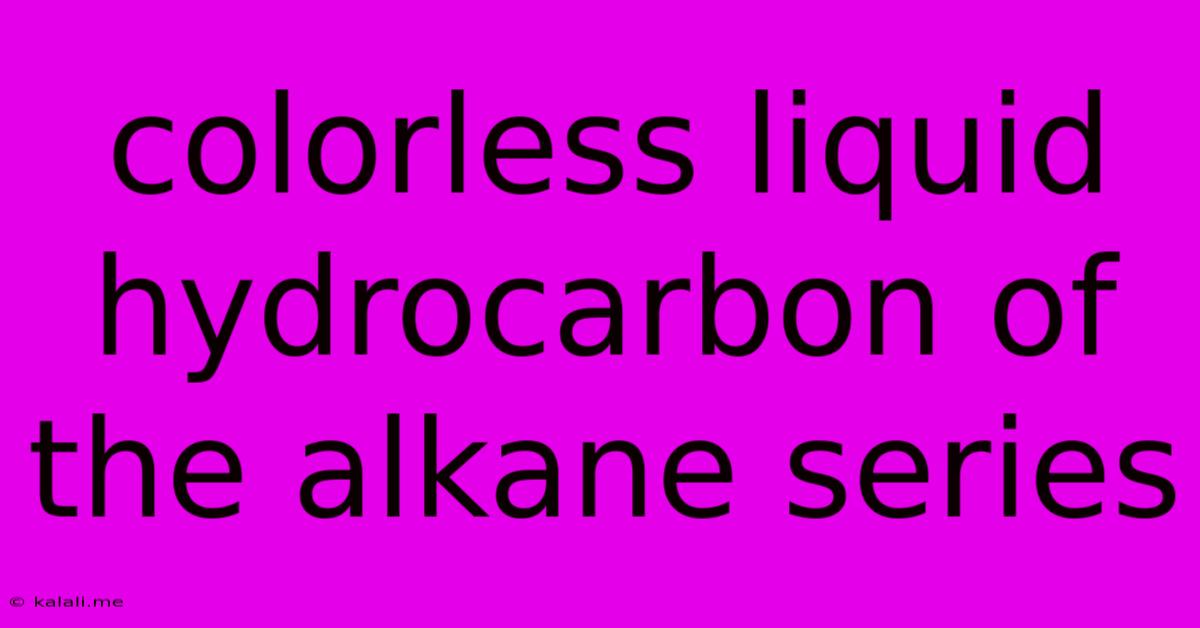Colorless Liquid Hydrocarbon Of The Alkane Series
Kalali
Jun 11, 2025 · 3 min read

Table of Contents
The Mysterious World of Colorless Liquid Alkanes: Exploring Their Properties and Applications
Colorless liquid hydrocarbons belonging to the alkane series are ubiquitous in our daily lives, yet often overlooked. This comprehensive guide delves into the fascinating world of these compounds, exploring their chemical properties, various applications, and safety considerations. Understanding these aspects is crucial for anyone working with or simply interested in the fundamental building blocks of organic chemistry.
What are Alkanes?
Alkanes are saturated hydrocarbons, meaning they consist solely of carbon and hydrogen atoms, with single bonds connecting all atoms. This simple structure is responsible for their characteristic properties. The "alkane" series refers to a homologous series, meaning each successive member differs by a single CH₂ unit. While smaller alkanes (like methane and ethane) are gases at room temperature, as the carbon chain length increases, they transition into liquids and eventually solids. It's these colorless liquid alkanes we'll be focusing on.
Properties of Colorless Liquid Alkanes:
- Color and Odor: As their name suggests, these hydrocarbons are typically colorless and odorless, although impurities can alter this. Their lack of odor makes them particularly challenging to detect in the event of a leak.
- Solubility: Alkanes are nonpolar molecules, making them insoluble in water (a polar solvent). However, they readily dissolve in nonpolar solvents like other hydrocarbons or organic solvents. This property influences their applications and handling.
- Boiling Point: The boiling point of a liquid alkane directly correlates with its molecular weight (and hence chain length). Longer chains experience stronger intermolecular forces (London dispersion forces), leading to higher boiling points.
- Flammability: Alkanes are highly flammable, a characteristic that necessitates careful handling and storage. Their combustion reactions produce carbon dioxide and water, releasing significant energy.
- Reactivity: Alkanes are relatively unreactive compared to other hydrocarbon classes (alkenes and alkynes). This low reactivity is due to the strong C-C and C-H bonds and the absence of reactive functional groups. They primarily undergo combustion and halogenation reactions.
Common Examples of Colorless Liquid Alkanes:
Several alkanes exist as colorless liquids at room temperature. These include:
- Pentane (C₅H₁₂): A volatile liquid used as a solvent and in gasoline blends.
- Hexane (C₆H₁₄): Another common solvent, frequently employed in the extraction of oils and fats.
- Heptane (C₇H₁₆): Used as a solvent and in the calibration of octane ratings in gasoline.
- Octane (C₈H₁₈): A major component of gasoline, its isomeric structure dictates octane rating – a measure of fuel efficiency and combustion properties.
- Nonane (C₉H₂₀) and Decane (C₁₀H₂₂): These higher alkanes are present in kerosene and diesel fuel.
Applications of Colorless Liquid Alkanes:
The versatility of colorless liquid alkanes is reflected in their wide range of applications:
- Solvents: Their nonpolar nature makes them excellent solvents for dissolving fats, oils, and other nonpolar substances.
- Fuels: Alkanes are the primary components of gasoline, kerosene, diesel fuel, and other petroleum products, serving as vital energy sources.
- Chemical feedstocks: They serve as starting materials in the petrochemical industry for the production of various polymers, plastics, and other chemicals.
- Laboratory applications: Used extensively in various laboratory procedures, such as chromatography and extraction.
Safety Considerations:
Given their flammability and potential health effects, caution is paramount when handling colorless liquid alkanes:
- Flammability: Always handle these substances away from open flames or ignition sources. Adequate ventilation is crucial to prevent the buildup of flammable vapors.
- Inhalation: Exposure to high concentrations of alkane vapors can cause dizziness, headaches, and even unconsciousness. Appropriate respiratory protection should be used.
- Skin contact: Prolonged skin contact can cause dryness and irritation. Protective gloves and clothing are recommended.
- Storage: Store alkanes in tightly sealed containers in cool, well-ventilated areas, away from incompatible materials.
Conclusion:
Colorless liquid alkanes, while seemingly simple molecules, play a significant role in our modern world. Understanding their properties, applications, and associated safety precautions is essential for responsible use and handling. Their importance in various industries, from fuels to solvents, highlights their continued relevance in chemical science and technology.
Latest Posts
Latest Posts
-
Which Of The Following Disasters Has A Slow Onset
Jun 12, 2025
-
Max Moment For Simply Supported Beam
Jun 12, 2025
-
The Motion Of Earth Around The Sun Is Called
Jun 12, 2025
-
A Positive Ion Is Called A
Jun 12, 2025
-
Distinguish Between Direct And Indirect Democracy
Jun 12, 2025
Related Post
Thank you for visiting our website which covers about Colorless Liquid Hydrocarbon Of The Alkane Series . We hope the information provided has been useful to you. Feel free to contact us if you have any questions or need further assistance. See you next time and don't miss to bookmark.